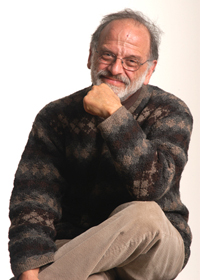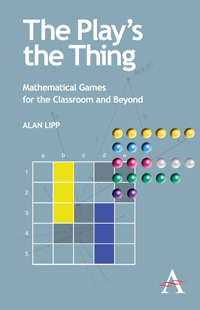Mathematics teacher Alan Lipp, who has taught at Williston since 1975 and was head of the Mathematics Department for nearly 20 years, has recently published The Play’s the Thing: Mathematical Games for the Classroom and Beyond, a book that presents 18 mathematical games and develops the concepts of game analysis and winning strategies.
 The book’s inception goes back to Williston’s Intersession program in the 1980s. One of the courses Mr. Lipp offered was a course in math games. He invented several of the games, but many of them are well-known, including Tic-Tac-Toe and Connect-the-Dots. All of the games have an underlying math theme, even if it is not apparent at first. His previous two books, published in 2000 and 2001, were supplements to textbooks for AP calculus. The Play’s the Thing is more general and intended for classroom use in grades 8-12.
The book’s inception goes back to Williston’s Intersession program in the 1980s. One of the courses Mr. Lipp offered was a course in math games. He invented several of the games, but many of them are well-known, including Tic-Tac-Toe and Connect-the-Dots. All of the games have an underlying math theme, even if it is not apparent at first. His previous two books, published in 2000 and 2001, were supplements to textbooks for AP calculus. The Play’s the Thing is more general and intended for classroom use in grades 8-12.
“Making math meaningful has been a theme throughout my career,” Mr. Lipp says. “Math should also be fun, interesting, and comprehensible.” He spent many years teaching seventh and eighth grade math in the Middle School, where he found that for students of that age, play was helpful and made topics more engaging. Even with the higher-level courses he teaches now (including AP Calculus and Discrete Mathematics), he will introduce topics in playful way, although eventually “we have to do a logical analysis in order to meet the challenge and mathematical import of what we’re looking at.”
 Though the games in The Play’s the Thing can be played by students at all levels, the book challenges students to develop a winning strategy: an effective way to win every time. With some of the games, known solutions exist, but with others, none have yet been found. In the Introduction, Mr. Lipp writes, “In some cases the answers are not known, but the question is presented in the belief that the search for an answer is worthwhile.”
Though the games in The Play’s the Thing can be played by students at all levels, the book challenges students to develop a winning strategy: an effective way to win every time. With some of the games, known solutions exist, but with others, none have yet been found. In the Introduction, Mr. Lipp writes, “In some cases the answers are not known, but the question is presented in the belief that the search for an answer is worthwhile.”
It is the playfulness of the search that has kept Mr. Lipp engaged in teaching math for more than 40 years. “You need to find something in the math that’s new and interesting, if you’re going to be teaching Algebra 1 twenty years in a row,” he says, “so I play math games all the time.”
He also credits Williston students with consistently inspiring his excellent teaching. “Every year I learn something new from my kids,” he says. “They’re creative, inventive, and inspiring.” He considers the students to be his best teachers, and since they have played his math games for years, he also feels that they indirectly helped write his book.

